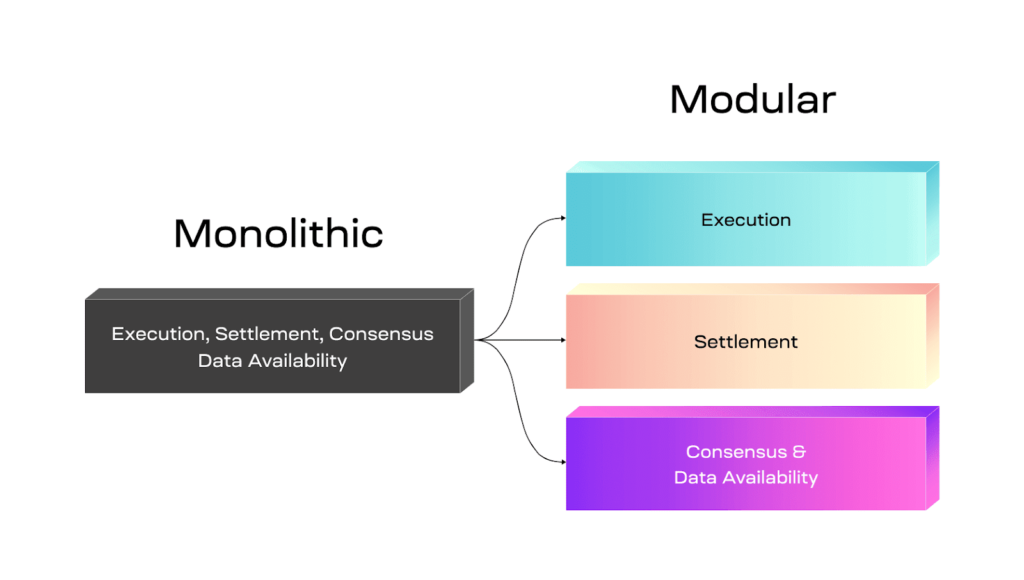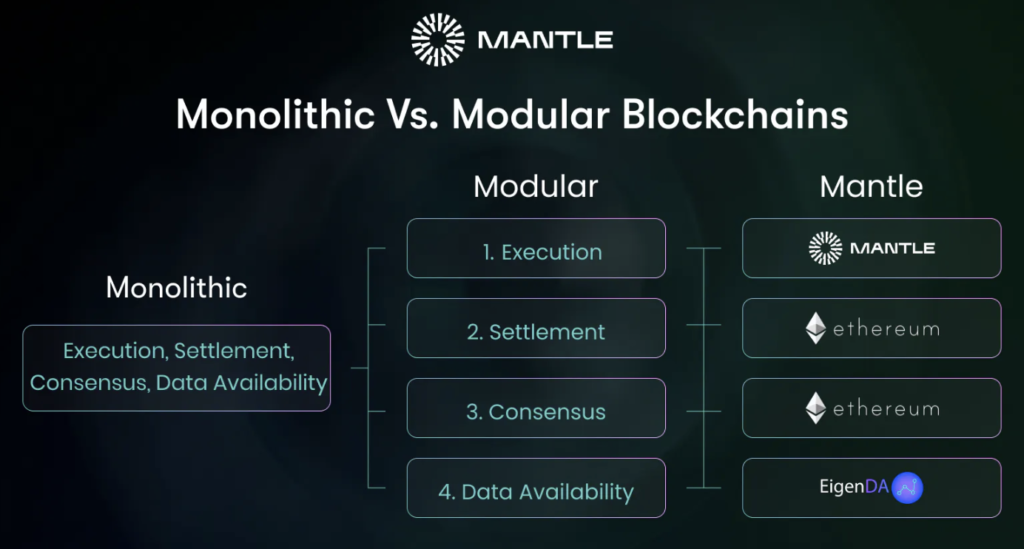Ethereum’s layer 2 sector is becoming more and more competitive. Arbitrum and Optimism have attracted many development teams and users to their networks. Not wanting to be left behind, Polygon announced a massive update with Polygon 2.0. Furthermore, the Dencun update at the end of 2023 will make all L2 rollup transactions much cheaper. All of this contributes to the significant activity coming from the sector. Mantle Network is one of the new L2 projects in the sector. So, what is Mantle Network? What are its advantages and how does it work? We will discuss it in detail.
Article Summary
- 🏁 Ethereum’s layer 2 (L2) sector is becoming increasingly competitive with projects like Arbitrum, Optimism, and Polygon growing. One of the new L2 networks is Mantle Network, a project supported by the BitDAO community.
- 📱 Mantle Network has a modular network architecture that allows each component in the network stack to be replaced and modified.
- 🏦 BitDAO is in the process of allocating $200 million dollars to fund the Mantle ecosystem. Also, to eliminate confusion, the BitDAO community change its name to Mantle Network and change the BIT token to MNT.
- ⚙️ Mantle works similarly to Optimism and Arbitrum, where transactions are processed using an off-chain validator known as a sequencer. In addition, Mantle differentiates itself from other L2 competitors by using a modular network and utilizing EigenDA as the data availability layer.
- ⚖️ Mantle Network offers advantages such as a modular blockchain design, substantial funding from BitDAO, Mantle LSD development, and cheaper transaction fees than other L2s. The Mantle Network’s native token is MNT, which serves as the governance token and gas fee in the Mantle Network ecosystem.
What is Mantle Network (MNT)?
Mantle Network is a layer 2 network on Ethereum. Mantle is an L2 network incubated by the BitDAO community. BitDAO is a DAO with the largest treasury in the world ($2.1 billion dollars in various cryptocurrencies). The Mantle network is EVM-compatible and uses Optimistic Rollup, similar to Optimism and Arbitrum. Currently, Mantle is still in the testnet phase.
Confused by the above explanation? You can read the article about what is layer 2 at Pintu Academy.
In addition, Mantle has a modular network architecture where each component of the network stack can be replaced and modified. Several modular blockchain projects have emerged in recent years (Celestia, Fuel, and Mantle). Modular design blockchains are another attempt to solve the Blockchain Trilemma. So, with modular blockchains, each layer can be swapped, modified, and replaced to create the ideal performance that suits the needs of the network.
What is Modular vs. Monolithic blockchain? Blockchain consists of several layers: execution, settlement, consensus, and data availability. In a monolithic blockchain like Solana, validators or nodes perform the functions of all layers. Blockchain with a modular design separates the work of a group of nodes for each layer. So, each layer has a number of nodes that specialize in the functions of that layer.
Mantle was essentially born out of the BitDAO community that had been discussing for the past few years how to evolve its DAO. In the end, the proposal to create L2 was approved by the majority of the BitDAO community. Furthermore, BitDAO is in the process of allocating $200 million dollars to fund the Mantle ecosystem.
Mantle Network has an official Youtube with a brief explanation of what is Mantle:
Why is BitDAO changing its name to Mantle Network?
In May 2023, the BitDAO community began discussions about merging the BitDAO and Mantle Network ecosystems. So, The final decision is to rebrand the BitDAO name and change it to Mantle Network. So, all names related to BitDAO now change to Mantle, including the BIT token to MNT. All BitDAO governance processes including token holders will remain unchanged. BitDAO emphasizes that this name change will only be cosmetic for BitDAO community as all governance process is still the same.
One of the most compelling arguments for this name change is to eliminate confusion in the roles and positions of Mantle and BitDAO. All network development activities, partnerships, etc are now under the Mantle Network umbrella. Currently, BitDAO is in the process of converting BIT tokens into MNT. BitDAO also explained that MNT tokenomics will change to match its role in the Mantle network.
How Does Mantle Work?

Mantle is an Optimistic Rollup L2 network. This puts Mantle similar to Optimism and Arbitrum. So, the way Mantle processes transactions is very similar to those two projects. All L2 networks process transactions by utilizing an off-chain validator called a sequencer that collects transactions from the L2 network and posts them to the Ethereum consensus network. So, On Ethereum, the transactions will be considered valid and settled.
You can also read the articles what is Arbitrum and what is Optimism on Pintu Academy to better understand how Optimistic Rollup L2 works.
Like other OR networks, there is a seven-day delay to check for malicious or incorrect transactions (called DTD or Dispute Time Delay). This checking for invalid transactions is done through Fraud Proof sent by L2 to Ethereum. Mantle enforces Interactive Fraud Proof which can be checked directly using EVM-level instructions. Therefore, Mantle’s Fraud Proof is compatible with all Ethereum clients, making it more secure.
Mantle also utilizes Multi-Party Computation (MPC) technology to reduce the delay in checking Fraud Proof. MPC is a new node function dedicated to checking the validity of blocks that have been posted to the network. So, The more MPC nodes that sign on block validity, the more Mantle’s transaction DTD time range is reduced.
Mantle DA, A Technology Powered by EigenDA

One of the uniqueness and advantages that Mantle has always emphasized is its modular architecture. Mantle is the only rollup-based L2 with a modular design. As mentioned, modular blockchains can replace and change any of their network components. In this case, Mantle swaps Ethereum’s data availability (DA) layer with Eigenlayer’s EigenDA technology.
Mantle chose to use EigenDA because the use of data availability on Ethereum is still very expensive. The DA layer is critical for rollups that must always be ready to upload fraud-proof in case of malicious transactions. Storing transaction data in Ethereum’s DA layer incurs high transaction and storage costs. Therefore, EigenDA exists to replace Ethereum’s data availability network with the much more advanced and faster EigenDA technology.
Mantle named its data availability solution Mantle DA because it is powered by EigenDA technology. Nodes or validators that choose to participate in Mantle DA are independent of other groups of validators and only perform DA-related tasks. The modularity of the Mantle DA layer enables higher transaction processing speeds and lower transaction costs than other L2 rollups.
Advantages of Mantle Network over other L2s
- Modular blockchain design: Mantle Network is the only Ethereum L2 project with a modular network architecture. This makes it easier for Mantle to improve its network performance because each component can be replaced as needed.
- Major funding from BitDAO: Mantle is a project born from the BitDAO community. Currently, Mantle has become the main pillar of the BitDAO community, which has been renamed to Mantle Governance with the MNT token. So, Mantle can utilize hundreds of millions of dollars of funding from the BitDAO community. However, all use of assets belonging to the BitDAO community needs to pass a governance process.
- Mantle LSD: Mantle has plans to develop Mantle LSD (Liquid Staking Derivatives). If this happens, Mantle will be the only L2 platform to have a built-in LSD product on its network. Mantle Governance is currently discussing the details of Mantle LSD.
- High speed and lower transaction costs than other L2s: The use of EigenDA as the data availability layer allows Mantle’s transaction costs to be lower than its competitors with faster speed.
MNT Token
MNT is a native token in the Mantle network with various functions in the Mantle ecosystem. The token name change from BIT to MNT was approved through BIP-21. MIP-22 (Mantle Improvement Proposal) is the proposal that converts BIT to MNT with a 1:1 ratio and approves the “mint” function and upgradeability parameters on MNT tokens. So, the Mantle Governance community (the name for the new BitDAO community) agrees that the function of the MNT token can be adjusted through the Mantle Governance system.
The main function of the MNT token is as a governance token within Mantle Governance. This function is the same as that of the ARB and OP tokens. However, unlike those two projects, MNT also has a use as a gas fee token within the Mantle Network ecosystem. This is possible because Mantle converts MNT to ETH for the users.
In addition, Mantle DA also allows Mantle to use a double token staking mechanism using MNT. Details on the interaction of MNT and Eigenlayer’s restaking infrastructure are yet to be determined. Mantle also has plans to create mntETH products as LSD tokens. Mantle LSD is still under discussion on the mantle Governance forum. All changes to the MNT token will need to go through the Mantle Governance process.
Conclusion
Ethereum’s layer 2 sector is becoming increasingly competitive with the emergence of major projects such as Arbitrum and Optimism. Mantle Network, an L2 project incubated by the BitDAO community, adds to the competitive dynamics by bringing the advantage of a modular blockchain. In addition, Mantle highlights its advantages in speed and transaction fees that are more efficient than other competitors thanks to the use of EigenDA technology in the data availability layer. With substantial funding from BitDAO, Mantle Network has the potential to become a major player in the layer 2 sector of Ethereum.
How to Buy MNT Tokens in the Pintu App
References
- “Overview – Network”, Mantle Docs, accessed on 7 July 2023.
- “An Introduction to Mantle — AMA Recap”, Mirror.xyz, accessed on 7 July 2023.
- 0xKira, “What Is Mantle Network? Ethereum Layer-2 Chain”, Coinmarketcap, accessed on 7 July 2023.
- “Key Concepts – Network”, Mantle Docs, accessed on 10 July 2023.
- Cooper Midroni dan Mantle Network, “Mantle: Unlocking the Potential of Modular Blockchain Scaling”, Mirror.xyz, accessed on 10 July 2023.
- “The New Mantle Token — AMA Recap. Another day, another Mantle rebranding”, Medium, accessed on 10 July 2023.
- @0xTindorr, “zkSync and Mantle are currently the top contenders for the next L2 go-to chain. However, the question is: who will be the winner?”, Twitter, accessed on 10 July 2023.
